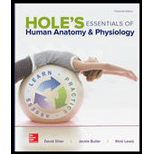
Hole's Essentials of Human Anatomy & Physiology
13th Edition
ISBN: 9781259277368
Author: David N. Shier Dr., Jackie L. Butler, Ricki Lewis Dr.
Publisher: McGraw-Hill Education
expand_more
expand_more
format_list_bulleted
Concept explainers
Question
Chapter 6.5, Problem 22P
Summary Introduction
To define: Granulation.
Introduction: Wound healing is a dynamic and complex process of replacing devitalized and missing cellular tissue layers and structures. Wound healing has four processes, namely homeostasis, inflammation, proliferation, and remodeling.
Expert Solution & Answer
Want to see the full answer?
Check out a sample textbook solution
Students have asked these similar questions
Briefly state the physical meaning of the electrocapillary equation (Lippman equation).
Explain in a small summary how:
What genetic information can be obtained from a Punnet square? What genetic information cannot be determined from a Punnet square?
Why might a Punnet Square be beneficial to understanding genetics/inheritance?
In a small summary write down:
Chapter 6 Solutions
Hole's Essentials of Human Anatomy & Physiology
Ch. 6.1 - Describe what constitutes an organ, and name the...Ch. 6.1 - Prob. 1PCh. 6.2 - Describe the structure of the layers of the...Ch. 6.2 - Prob. 3LCh. 6.2 - List the layers of the skin.
Ch. 6.2 - Name the tissues in the outer and inner layers of...Ch. 6.2 - Name the tissues in the subcutaneous layer beneath...Ch. 6.2 - What are the functions of the subcutaneous...Ch. 6.2 - Prob. 1QCh. 6.2 - Explain how the epidermis is formed.
Ch. 6.2 - Distinguish between the stratum basale and the...Ch. 6.2 - What is the function of melanin?
Ch. 6.2 - Prob. 9PCh. 6.2 - What types of tissues make up the dermis?
Ch. 6.2 - What are the functions of these tissues?
Ch. 6.3 - Describe the accessory structures associated with...Ch. 6.3 - Prob. 1QCh. 6.3 - Describe the structure of the nail bed.
Ch. 6.3 - Explain how a hair forms.
Ch. 6.3 - What is the function of the sebaceous glands?
Ch. 6.3 - Prob. 15PCh. 6.4 - List various skin functions and explain how the...Ch. 6.4 - List the functions of the skin.
Ch. 6.4 - Prob. 17PCh. 6.4 - Prob. 18PCh. 6.5 - Prob. 6LCh. 6.5 - Prob. 19PCh. 6.5 - Prob. 20PCh. 6.5 - Prob. 21PCh. 6.5 - Prob. 22PCh. 6 - Prob. 1CACh. 6 - Prob. 2CACh. 6 - Prob. 3CACh. 6 - The __________ layer of epidermal cells contains...Ch. 6 - Prob. 5CACh. 6 - Prob. 6CACh. 6 - Prob. 7CACh. 6 - Prob. 8CACh. 6 - Prob. 9CACh. 6 - Prob. 10CACh. 6 - Prob. 11CACh. 6 - Prob. 12CACh. 6 - Prob. 13CACh. 6 - Prob. 14CACh. 6 - Prob. 15CACh. 6 - Prob. 16CACh. 6 - Prob. 17CACh. 6 - Prob. 1IACTCh. 6 - Prob. 2IACTCh. 6 - Prob. 3IACTCh. 6 - Prob. 4IACTCh. 6 - Prob. 5IACTCh. 6 - Prob. 6IACT
Knowledge Booster
Learn more about
Need a deep-dive on the concept behind this application? Look no further. Learn more about this topic, biology and related others by exploring similar questions and additional content below.Similar questions
- Not part of a graded assignment, from a past midtermarrow_forwardNoggin mutation: The mouse, one of the phenotypic consequences of Noggin mutationis mispatterning of the spinal cord, in the posterior region of the mouse embryo, suchthat in the hindlimb region the more ventral fates are lost, and the dorsal Pax3 domain isexpanded. (this experiment is not in the lectures).a. Hypothesis for why: What would be your hypothesis for why the ventral fatesare lost and dorsal fates expanded? Include in your answer the words notochord,BMP, SHH and either (or both of) surface ectoderm or lateral plate mesodermarrow_forwardNot part of a graded assignment, from a past midtermarrow_forward
- Explain in a flowcharts organazing the words down below: genetics Chromosomes Inheritance DNA & Genes Mutations Proteinsarrow_forwardplease helparrow_forwardWhat does the heavy dark line along collecting duct tell us about water reabsorption in this individual at this time? What does the heavy dark line along collecting duct tell us about ADH secretion in this individual at this time?arrow_forward
arrow_back_ios
SEE MORE QUESTIONS
arrow_forward_ios
Recommended textbooks for you
 Human Anatomy & Physiology (11th Edition)BiologyISBN:9780134580999Author:Elaine N. Marieb, Katja N. HoehnPublisher:PEARSON
Human Anatomy & Physiology (11th Edition)BiologyISBN:9780134580999Author:Elaine N. Marieb, Katja N. HoehnPublisher:PEARSON Biology 2eBiologyISBN:9781947172517Author:Matthew Douglas, Jung Choi, Mary Ann ClarkPublisher:OpenStax
Biology 2eBiologyISBN:9781947172517Author:Matthew Douglas, Jung Choi, Mary Ann ClarkPublisher:OpenStax Anatomy & PhysiologyBiologyISBN:9781259398629Author:McKinley, Michael P., O'loughlin, Valerie Dean, Bidle, Theresa StouterPublisher:Mcgraw Hill Education,
Anatomy & PhysiologyBiologyISBN:9781259398629Author:McKinley, Michael P., O'loughlin, Valerie Dean, Bidle, Theresa StouterPublisher:Mcgraw Hill Education, Molecular Biology of the Cell (Sixth Edition)BiologyISBN:9780815344322Author:Bruce Alberts, Alexander D. Johnson, Julian Lewis, David Morgan, Martin Raff, Keith Roberts, Peter WalterPublisher:W. W. Norton & Company
Molecular Biology of the Cell (Sixth Edition)BiologyISBN:9780815344322Author:Bruce Alberts, Alexander D. Johnson, Julian Lewis, David Morgan, Martin Raff, Keith Roberts, Peter WalterPublisher:W. W. Norton & Company Laboratory Manual For Human Anatomy & PhysiologyBiologyISBN:9781260159363Author:Martin, Terry R., Prentice-craver, CynthiaPublisher:McGraw-Hill Publishing Co.
Laboratory Manual For Human Anatomy & PhysiologyBiologyISBN:9781260159363Author:Martin, Terry R., Prentice-craver, CynthiaPublisher:McGraw-Hill Publishing Co. Inquiry Into Life (16th Edition)BiologyISBN:9781260231700Author:Sylvia S. Mader, Michael WindelspechtPublisher:McGraw Hill Education
Inquiry Into Life (16th Edition)BiologyISBN:9781260231700Author:Sylvia S. Mader, Michael WindelspechtPublisher:McGraw Hill Education

Human Anatomy & Physiology (11th Edition)
Biology
ISBN:9780134580999
Author:Elaine N. Marieb, Katja N. Hoehn
Publisher:PEARSON

Biology 2e
Biology
ISBN:9781947172517
Author:Matthew Douglas, Jung Choi, Mary Ann Clark
Publisher:OpenStax

Anatomy & Physiology
Biology
ISBN:9781259398629
Author:McKinley, Michael P., O'loughlin, Valerie Dean, Bidle, Theresa Stouter
Publisher:Mcgraw Hill Education,

Molecular Biology of the Cell (Sixth Edition)
Biology
ISBN:9780815344322
Author:Bruce Alberts, Alexander D. Johnson, Julian Lewis, David Morgan, Martin Raff, Keith Roberts, Peter Walter
Publisher:W. W. Norton & Company

Laboratory Manual For Human Anatomy & Physiology
Biology
ISBN:9781260159363
Author:Martin, Terry R., Prentice-craver, Cynthia
Publisher:McGraw-Hill Publishing Co.

Inquiry Into Life (16th Edition)
Biology
ISBN:9781260231700
Author:Sylvia S. Mader, Michael Windelspecht
Publisher:McGraw Hill Education